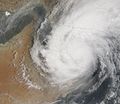Файл:Gonu 06 jun 2007 0715Z.jpg
Перейти к навигации
Перейти к поиску

Размер этого предпросмотра: 692 × 600 пкс. Другие разрешения: 277 × 240 пкс | 554 × 480 пкс | 886 × 768 пкс | 1182 × 1024 пкс | 2363 × 2048 пкс | 3900 × 3380 пкс.
Исходный файл (3900 × 3380 пкс, размер файла: 1,15 МБ, MIME-тип: image/jpeg)
История файла
Нажмите на дату/время, чтобы посмотреть файл, который был загружен в тот момент.
| Дата/время | Миниатюра | Размеры | Участник | Примечание | |
|---|---|---|---|---|---|
| текущий | 15:18, 9 июня 2007 |  | 3900 × 3380 (1,15 МБ) | Good kitty | == Summary == {{Information |Description=A cyclonic storm like Tropical Cyclone Gonu might not seem an odd sight until you consider that Gonu is heading northwest into the Gulf of Oman. The most recent storm of this magnitude to hit the Sultanate of Oman |
Использование файла
Нет страниц, использующих этот файл.
Глобальное использование файла
Данный файл используется в следующих вики:
- Использование в en.wikipedia.org

